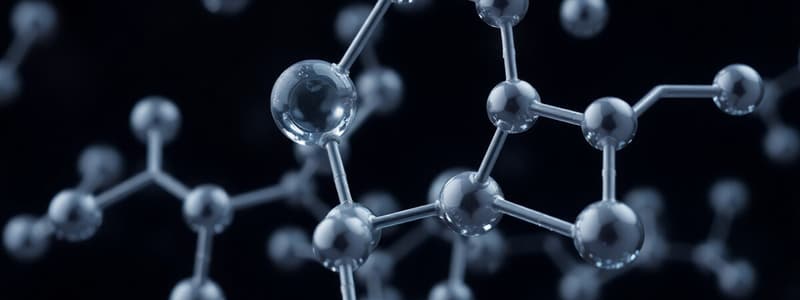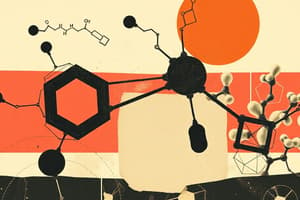Podcast
Questions and Answers
Why is carbon considered a fundamental element in living organisms?
Why is carbon considered a fundamental element in living organisms?
- It is the most abundant element in the universe.
- It can form a wide variety of stable bonds. (correct)
- It exists as a gas at room temperature.
- It has a high atomic weight.
What is the general formula for carbohydrates?
What is the general formula for carbohydrates?
- (CHO)n
- (C2H4O2)n
- (C6H12O6)n
- (CH2O)n (correct)
Which of the following macromolecules is primarily responsible for storing genetic information?
Which of the following macromolecules is primarily responsible for storing genetic information?
- Carbohydrates
- Lipids
- Proteins
- Nucleic Acids (correct)
What type of carbohydrate consists of two monosaccharides joined together?
What type of carbohydrate consists of two monosaccharides joined together?
Which of the following is NOT considered a type of biological macromolecule?
Which of the following is NOT considered a type of biological macromolecule?
What is the primary function of lipids in living organisms?
What is the primary function of lipids in living organisms?
What is the monomer of lipids?
What is the monomer of lipids?
Which function does not correspond with carbohydrates?
Which function does not correspond with carbohydrates?
Which of the following is a monosaccharide?
Which of the following is a monosaccharide?
What characterizes disaccharides?
What characterizes disaccharides?
What characterizes saturated fats?
What characterizes saturated fats?
Which of the following is NOT a characteristic of lipids?
Which of the following is NOT a characteristic of lipids?
What is the primary function of proteins?
What is the primary function of proteins?
What is a polymer made of monosaccharides called?
What is a polymer made of monosaccharides called?
Which of the following is a type of lipid?
Which of the following is a type of lipid?
Which statement describes the structure of nucleotides?
Which statement describes the structure of nucleotides?
What is the main function of carbohydrates in living organisms?
What is the main function of carbohydrates in living organisms?
What distinguishes monosaccharides from disaccharides?
What distinguishes monosaccharides from disaccharides?
In which places in the body is glycogen primarily stored?
In which places in the body is glycogen primarily stored?
What is the quaternary structure of a protein?
What is the quaternary structure of a protein?
What is the structure of a fatty acid primarily made up of?
What is the structure of a fatty acid primarily made up of?
Which type of nucleic acid is responsible for storing genetic information?
Which type of nucleic acid is responsible for storing genetic information?
What is a key feature of carbohydrates?
What is a key feature of carbohydrates?
What is the primary structure of proteins?
What is the primary structure of proteins?
Which statement accurately describes saturated fatty acids?
Which statement accurately describes saturated fatty acids?
What distinguishes unsaturated fatty acids from saturated fatty acids?
What distinguishes unsaturated fatty acids from saturated fatty acids?
What are triglycerides primarily composed of?
What are triglycerides primarily composed of?
Which of the following is an example of an unsaturated fatty acid?
Which of the following is an example of an unsaturated fatty acid?
What is the role of proteins in the body?
What is the role of proteins in the body?
What is the building block of proteins?
What is the building block of proteins?
What is true about the R group in amino acids?
What is true about the R group in amino acids?
Which of the following best describes lipids?
Which of the following best describes lipids?
What occurs when a protein undergoes denaturation?
What occurs when a protein undergoes denaturation?
Which of the following is a characteristic of nucleic acids?
Which of the following is a characteristic of nucleic acids?
What is the primary reason that a protein's folded shape is important?
What is the primary reason that a protein's folded shape is important?
Which of the following nitrogenous bases is found in RNA but not in DNA?
Which of the following nitrogenous bases is found in RNA but not in DNA?
Which component is NOT a part of a nucleotide?
Which component is NOT a part of a nucleotide?
What are the building blocks of proteins?
What are the building blocks of proteins?
Which of the following describes polypeptides?
Which of the following describes polypeptides?
What happens to proteins when they are exposed to heat or chemicals?
What happens to proteins when they are exposed to heat or chemicals?
Study Notes
Carbon's Role in Life
- Carbon is a fundamental element found in all living organisms.
- Carbon forms the backbone of all biological molecules.
- Carbon has four electrons in its outermost shell, enabling it to form four covalent bonds.
- These bonds allow carbon to create a wide range of molecules, including long chains, branched chains, and rings.
Macromolecules: The Building Blocks of Life
- Macromolecules are large molecules formed by joining smaller organic molecules together.
- They're also called polymers.
- Polymers consist of repeating units of monomers linked by covalent bonds.
Carbohydrates: Energy Powerhouses
- Carbohydrates are organic molecules made of carbon, hydrogen, and oxygen in a 1:2:1 ratio.
- Their general formula is (CH2O)n, where 'n' represents the number of CH2O units.
- Carbohydrates are essential for energy storage and structural support in organisms.
- They are classified as either simple (sugars) or complex (polysaccharides) based on their structure.
Simple Carbohydrates: Sweet Energy
- Simple carbohydrates are sugars made of single or two sugar molecules.
- Monosaccharides are single sugar units, like glucose, fructose, and galactose.
- Disaccharides are two monosaccharides bonded together, like sucrose (table sugar).
Complex Carbohydrates: Long-Chain Energy
- Complex carbohydrates contain long chains of multiple monosaccharides.
- Each monosaccharide is a monomer in the long chain, forming a polymer.
- Examples of polysaccharides include cellulose for structural support in plants, starch for energy storage in plants, and glycogen for energy storage in animals.
Lipids: The Fats and Oils
- Lipids are organic molecules primarily made up of carbon, hydrogen, and oxygen, often with a high proportion of carbon and hydrogen.
- They are essential components of cell membranes and serve as long-term energy storage.
- Lipids include fats, oils, waxes, and steroids.
Fatty Acids: Building Blocks of Lipids
- Fatty acids are the monomers of lipids, containing a chain of carbon atoms with attached hydrogen atoms.
- Saturated fatty acids have only single bonds between carbons, are saturated with hydrogen, and are typically solid at room temperature.
- Unsaturated fatty acids contain at least one double bond between carbon atoms, have gaps in hydrogen saturation, and are typically liquid at room temperature.
Triglycerides: Energy Storage
- Triglycerides are lipid polymers formed when three fatty acids bond to a glycerol molecule.
- Saturated triglycerides contain only saturated fatty acids.
- Unsaturated triglycerides contain at least one unsaturated fatty acid.
Proteins: The Versatile Workers
- Proteins are organic molecules composed of carbon, hydrogen, oxygen, and nitrogen.
- They play various roles in the body, including structural support, transport, signaling, speeding up chemical reactions, and controlling cell growth.
- Proteins are made of amino acids joined by peptide bonds.
Amino Acids: Protein Building Blocks
- Amino acids are the monomers of proteins, containing an amino group, a carboxyl group, and a unique side chain (R group).
- There are 20 different amino acids, each with a unique R group.
- Peptides are small proteins made up of few amino acids.
- Polypeptides are long chains of amino acids that make up a protein.
Protein Structure: Form Function
- A protein's shape is crucial to its function.
- Proteins can have up to four levels of structure: primary (amino acid sequence), secondary (helix or pleated sheet), tertiary (globular), and quaternary (combination of proteins).
- Denaturation occurs when a protein's shape changes, but not its amino acid sequence.
- Heat or chemicals can cause denaturation, which is often irreversible.
Nucleic Acids: The Information Carriers
- Nucleic acids are organic macromolecules that store and transmit genetic information.
- They consist of nucleotides linked together in a chain.
- DNA and RNA are the two main types of nucleic acids.
Nucleotides: Building Blocks of Nucleic Acids
- Nucleotides are composed of a phosphate group, a five-carbon sugar (pentose), and a nitrogenous base.
- DNA contains four nitrogenous bases: adenine (A), thymine (T), cytosine (C), and guanine (G).
- RNA contains four nitrogenous bases: adenine (A), uracil (U), cytosine (C), and guanine (G).
- Nucleotides bond through their phosphate group and sugar to form nucleic acid polymers.
DNA and RNA: Blueprints of Life
- DNA is a double-stranded nucleic acid, with two strands linked by hydrogen bonds between nitrogenous bases.
- RNA is a single-stranded nucleic acid.
Studying That Suits You
Use AI to generate personalized quizzes and flashcards to suit your learning preferences.
Related Documents
Description
Explore the crucial role of carbon in forming the backbone of biological molecules and its importance in macromolecules. This quiz covers the structure and function of carbohydrates, the building blocks of life, that provide energy and structural support. Test your understanding of these foundational concepts in biology.




